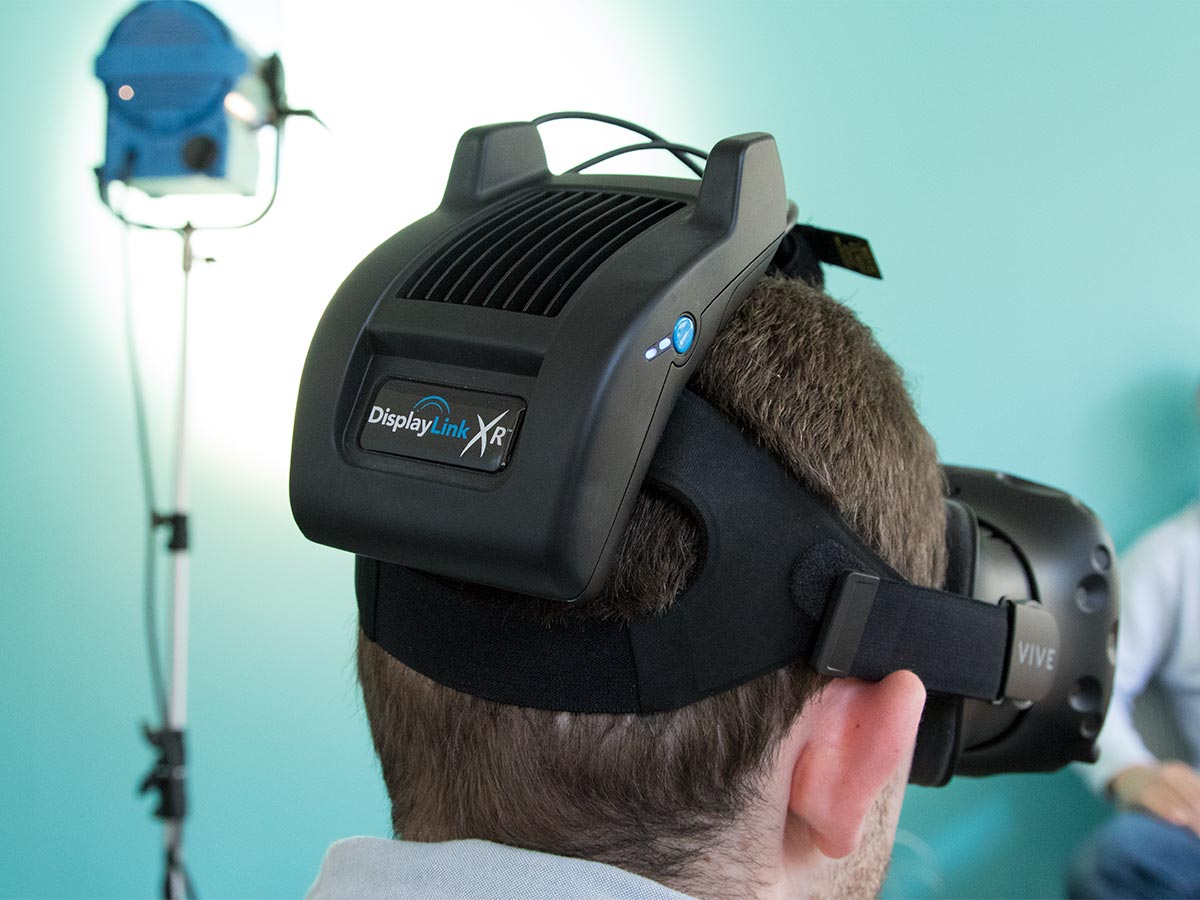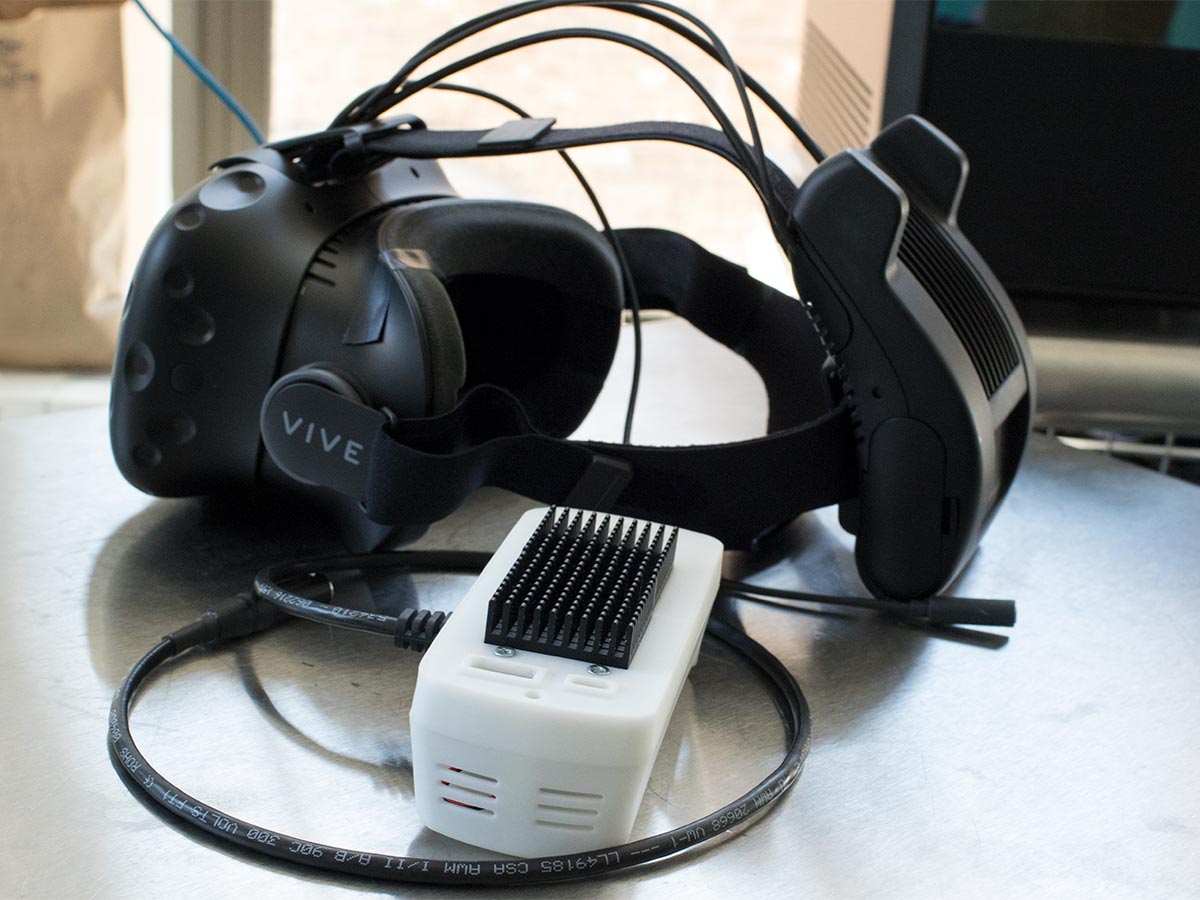How an Enterprise Docking Company Became the Leader in Wireless VR
Known for its laptop docks, DisplayLink is an unlikely candidate to build the next big-thing in VR, but it just did.
The worst biggest issue with PC-based VR has been that a cord physically connects you to the computer, limiting your movement and hindering immersion. Take too many steps the wrong way and -- Bam -- your $1,500 computer is yanked onto the ground.
But what if your HTC Vive or Oculus Rift were wireless? It soon may be.

DisplayLink, a company that makes the hardware inside laptop docking stations is an unlikely source of VR innovation. But at E3, it's showing DisplayLink XR, a new technology that lets you cut the cord on headsets like the Vive, to the public for the first time.
Prior to the show, DisplayLink execs stopped by the Tom’s Guide offices to give us an exclusive first look at the technology and tell us the story of how they became the unlikely steward of wireless VR with a product that's set to launch either late this year or early next year for around $249.
DisplayLink XR, as the company showed us, is a module that attaches to the back of the headset (we saw it with an HTC Vive) and connects to your computer with a series of 60GHz radios. Alternatively, the tech could also be built into future headsets. And it turns out that it’s not so different from a wireless enterprise dock.
The company’s core technology is a chip combined with a low-latency video codec, perfect for moving a mouse across multiple desktops. It has been been developing these chips and selling them to dock-makers such as Dell, Targus and Plugable since 2003.
While the company had ordered and played around with an early Oculus Rift development kit, it wasn’t until Mobile World Congress in Barcelona in March 2016 when the idea of developing for VR clicked in.
“I actually filmed this; I still have the video of a guy who had been in line for 30 minutes,” said Graham O’Keeffe, chairman and CEO of DisplayLink. “He put it on, I think he was playing Space Pirate Trainer, or whatever, and he was shooting some stuff. And suddenly he sort of ducked and I was like ‘he really believes he’s on a pirate ship. There’s a lot more than meets the eye.’”
MORE: Best VR Headsets - Virtual Reality for PCs and Smartphones
Graham said he and Jonathan Jeacocke, DisplayLink’s vice president of technology, discussed the matter later over coffee, and remarked that the wire was a problem. It got in the way. But they were already part of the way to a solution.
“Our technology, it’s low-latency,” Graham said. “We've done wireless displays before and we started looking at [VR] going 'we could do this wirelessly and we could adapt some of the stuff we've done. We've worked on a lot of docks on and off over the years. Let’s just use the guts of a wireless dock and get something that works.'”
They brought a prototype to Computex in Taipei in 2016, but it was in a backpack and had a tendency to crash. But the concept was there, so DisplayLink assigned a team to work on it for six months to have it ready for CES in Las Vegas in January, which was the first time I saw the device. Even that was difficult, O’Keeffe and Andy Davis, director of marketing told me. Despite having a nicer-looking, 3D-printed model, a team was still working the week before the show to get it ready to show to the press and industry reps.

At CES, however, it didn’t look like a finished product, including a battery pack meant for a drill (they could get them easily from hardware stores, which was perfect for travelling, O’Keeffe said) and an older DisplayLink 3000-series chip that could leave 3 to 4 milliseconds of latency.
But it impressed and the company would go on to show the same prototype at this year’s Computex before the current version, which has an 8000-series chip with better graphical fidelity and almost no latency at all. This version puts the batteries in the headset (they’re medical-grade, which O’Keeffe says makes them safe to put on your head).
DisplayLink’s docks typically run dual 1080p monitors (though 4K is certainly an option) at 60Hz. An HTC Vive or Oculus Rift have two lenses, one per eye, at 1080 x 1200, each at 90Hz. O’Keefe says you can tolerate about 100ms of delay through a dock without noticing your mouse isn’t moving perfectly, but you will sure as heck notice it in VR.
“In VR, you’ve got 20 milliseconds to do the whole thing,” O’Keefe said. “20 milliseconds is two frames. That includes detecting the head’s moved, sending that computer back to the computer, the computer generates a scene, it streams the video out and you have to be able to display it all in 20 milliseconds.” The DisplayLink team had to modify existing docking chips to get the latency down, including adjusting their compression method.
DisplayLink’s codec is network-aware. If there’s any issue with the 60Ghz WiGig radios, it can stretch frames and change compression levels to prevent stuttering. And it should be future-proof, the team says. It can handle 4K resolution and support HDR.
“It’s in the secret sauce of what we do,” he said. “We don’t talk about how we do that.”
They’re not taking this first public showing lightly, especially with the new tech. In fact, when company execs arranged to go to E3, they weren’t yet aware that it would be the first year that anyone could buy a ticket to attend.
“It was literally a couple of weeks after [booking] that we realized they were opening it up to everybody,” Davis said. “We’re going to see some of the world’s pro gamers appearing and the challenge is really going to be there.”
Of course, you don’t take this kind of product to E3 without the hopes of making deals. DisplayLink execs tell me that they’re already talking to any partner you would expect them to be, but were careful not to explicitly name anyone. They also say developers will be interested.
“I think we're going to see a content explosion because studios have wrapped their minds around [it].” Davis said. Studios will be able to focus more on motion in game and not be restricted, to, say, forward-facing shooting games.
We should see how well DisplayLInk XR catches on in a few months. While they couldn’t provide firm dates, O’Keeffe and Davis suggested we could see more news, or even early devices based on the tech, this fall, including a module you can attach to current-generation headsets like the Vive and Rift selling for around $249.
When DisplayLink XR hits the market, we can start truly exploring VR, without that strange tugging feeling on the backs of our necks.
Sign up to get the BEST of Tom's Guide direct to your inbox.
Get instant access to breaking news, the hottest reviews, great deals and helpful tips.
Andrew E. Freedman is an editor at Tom's Hardware focusing on laptops, desktops and gaming as well as keeping up with the latest news. He holds a M.S. in Journalism (Digital Media) from Columbia University. A lover of all things gaming and tech, his previous work has shown up in Kotaku, PCMag, Complex, Tom's Guide and Laptop Mag among others.

